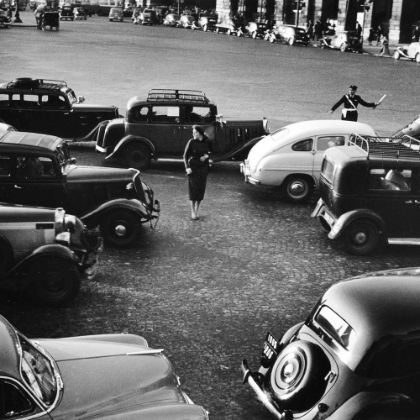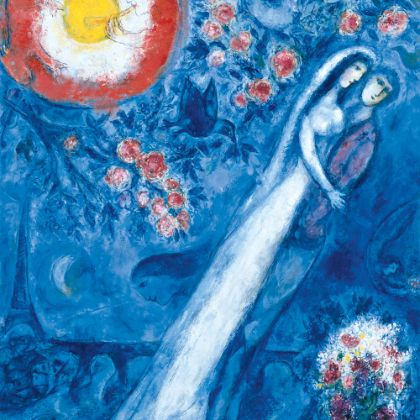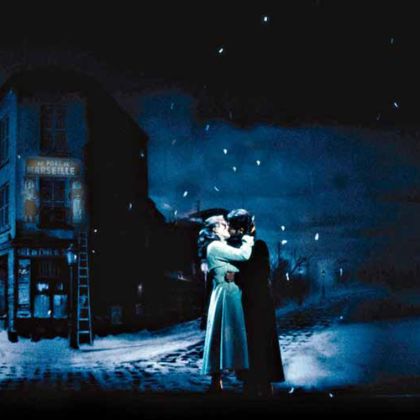jordi savall crosses the chasm vast.
By Ben Finane
a sad-eyed Spaniard with a French-ish accent, Jordi Savall is one of the greatest living forces in the rebirth of early music and has devoted his life to rediscovering, researching and sharing forgotten musical treasures. Savall studied the cello and then mastered the viola da gamba, his chief instrument. He founded the early-music ensemble Hespèrion XX (now XXI) in 1974 with his late wife, the soprano Montserrat Figueras, who passed away in November of last year. In 1987 he founded the vocal group Capella Reial de Catalunya and in 1989 the period-instrument orchestra Le Concert des Nations, which brings together young musicians, primarily from Latin countries. Following his lauded contribution to Alain Corneau’s 1991 film Tous les matins du monde starring tous les deux Depardieux, Savall was able to launch his own record label, Alia Vox, which has introduced early music to a wider public in resplendent luxury and style. His various projects have yielded close to two hundred recordings. In 2008, UNESCO appointed Savall an “Artist for Peace” and in 2009 he was appointed an Ambassador of the European Year for Creativity and Innovation by the European Union. I met with Savall at his hotel on Manhattan’s Upper East Side, but the interview was conducted at a nearby Italian eatery. We spoke over his morning green tea but under the blare of R&B.
You’re known for Baroque music, “early music” and “world music,” but these categories don’t seem fair, as they’re both overly vague and yet too restricting for what you do. Maybe you could talk about these projects of yours, what it is you’re trying to accomplish.
What interests me is the power of music to make dialogue possible and the power of music to change our lives. It’s these two elements that move me to develop certain repertories, related to certain historical moments. For me, the best way to define what I am doing is to say: ‘I am a musician.’ And I don’t like to be classified — the only thing one can say is that my specialty is the viola da gamba. But still, I’m a viola da gamba player who plays also rebec, rebab, lyre, Celtic viol.
The repertoire is determined, then, by that choice of instruments — that guides the decisions.
Always. In the first place, it’s the music. What moved me to the cello when I was young was the music. My voice had changed, and I sought out something that could reflect that change [Savall has said that ‘all music comes from the voice’], and I found cello. And when I started cello in those first years, I realized I was working more like an archaeologist — looking for pieces of music myself. And I found pieces by Marais, by Couperin, by Bach for viola da gamba. And I also developed an interest — with Montserrat — in the Sephardic world, the Arab or Andalusian world, the Oriental repertories, stemming from our strong sense of genetic conscience from the Spanish multicultural history.
So Spain itself is responsible for your multicultural approach. Is that fair to say?
In his description of Spain and Italy, Erasmus says you cannot find one Christian person in Spain [laughs] — in 1515. When I am in Arabic countries, I look very normal. Our mix in history now moves our conscience. In 1492 we broke bridges with the expulsion of the Jews — and with the expulsion of the Moors, we broke the bridges between Orient and Occident.
And so, are you in the process of rebuilding those bridges?
Music is the best school for learning dialogue, learning to share, to accept others, to build something. With Montserrat, maybe we were not so conscious of this in the beginning, but more and more we saw the importance of using music as a way of reaching over cultural walls. We have seen this in musicians from Japan, Afghanistan, Iran, Palestine, Morocco, to lose the problem of language in music.
In a speech in 2001, Bill Clinton said that terrorists ‘thought that the differences they have with us, political and religious, were all that mattered — and served to make all their targets less than human. Most of us believe that our differences are important and make our lives interesting but that our common humanity matters more. The clash between these two views over this simple question more than any other single issue,’ Clinton concluded, ‘will define the shape and the soul of this new century.’ Is part of your goal to recognize that there aren’t islands of music, to find similarities?
The first thing is to recognize that we are educated in the Occident to have a vision of the world from a point of supremacy. This is received. Even very sensitive people have said for hundreds of years ‘Oh, I am tolerant.’ To be tolerant...
— implies superiority.
Yes. ‘I tolerate this.’ So the first thing we have to do is to be conscious that we are not better, that our world has positive things but that other worlds have different perceptions and concepts and values, les valeurs. And when you play music with other musicians, you choose to play with them because they are nice, or because you like how they play or sing, or because you feel it would be a nice thing to do together. But there is first and foremost a certain empathy. Then, when you come together, you have to listen to the others, to learn how to start a dialogue; they have to participate in the same way, with you. Music making is the best way to learn intercultural dialogue. You cannot do music if you can’t decide together what to play and how to play and how to leave space for others when you are playing. It’s only if you find a certain harmony that you can do music. Even when people are open, it can be difficult. When I was working with Armenians and Turks and asked the Armenians to play a Turkish march, their first reaction was ‘No, please, this is not for us.’
We live in a world in which every day is worse and worse and worse. The climate, social, financial, political — it’s dispiriting because you don’t see eye to eye. But the world can be safe if each of us is concerned. This starts with our own life, with our family, with our friends, with our village. If everybody was ready to help others, to do something, the world would be different. We are too ready to say, ‘Well, this is not my problem,’ and I think when you see the reaction from fanatical people, you see that the first enemy of humans is ignorance. Ignorance makes fanatics. The second enemy is hatred. And the third is egoism. And all these things can be saved with the development of a sensitive language, like music. Within a class of young black and white students singing, there’s no racism. When people share the beauty of music, you cannot develop these fanatical elements.
As you have investigated more and more musics, what have you discovered as far as musical commonalities?
In the world of classical music, a lot has already been investigated, and there remain few chances to discover a new Bach or a new Monteverdi. But one important discovery I made with Montserrat occurred when we started to explore Sephardic music — in the very beginning of Hespèrion — was that these differences between classical music and folk music or traditional music are very artificial and incorrect. Because why is it that these songs have been conserved for five hundred, six hundred years — without being associated with a famous composer, without being written in a nice manuscript — from fathers to children? And this is simply because this music has had people who have ensured its survival. This is a constant in all societies that suffered persecution or hunger or were minorities — for example, Scots, Irish, Armenian, Basques, Catalans — and the question always comes up: why does this music have such power of emotion and beauty? Well, imagine a family expelled from Spain that arrives in Istanbul in a world where they know no one; and after terrible travel and problems, what do they do? They sing something together. And only in this moment of singing does their peace arrive. And these people conserved these songs because they were the necessary food for having peace and hope. And this is the constant that has moved me to work in these Oriental, Celtic and Armenian repertories because I found in this music something exceptional — this quality of having a strong, simple and emotional message. And this is, for me, the most important thing. A simple Sephardic melody gives me as much energy, beauty and emotion as a big symphony from Mahler. This is the magical mystery of music. This corresponds with life, if you think about it. All the most important and beautiful moments of life are intimate. In the life I shared with Montserrat, we saw this too, in the choice of repertory. We saw that life is too short to play everything, and so you look in music for good friends. One philosopher says: ‘If you want happiness, find a friend and stay close to him.’
There must be an enormous amount of research and scholarship you have to undertake every time you dive in to one of your musical projects. How does that process work? And are you concerned — when you’re investigating a new music — about authenticity? Is there such a thing as ‘authenticity’?
Authenticity can be used for different aspects — for an instrument, for playing, for style — but it is, in a certain way, quite relative. For example, take an orchestra playing Bach with original instruments. How can we know if this is authentic or not? Art is not a science. You don’t have a machine that can tell you: ‘This is one hundred percent authentic; this is fifty percent authentic.’ In this context, I think authenticity is important in the process of learning about the music. What is important for a musician is to know. If the enemy is ignorance, the best friend is knowledge. Freedom depends on knowledge. The more you know, the more you are free. The next project, for example, is the CD–book Jeanne d’Arc [(Alia Vox)]. Previously, I had read about the history of France and all that. Over the last two years, I have traveled with books about Jeanne d’Arc full of details and I was reading and marking the most important things — practically living with Jeanne d’Arc for two years.
With music, you must know about history, about current events, how we can prepare a better life. If an artist is not able to change the world, he’s not an artist.
And what does this give you, this cohabitation with Jeanne d’Arc?
This gives you the feeling that you are ready to put the life of Jeanne d’Arc in a musical context and find for every moment the corresponding musical atmosphere that can help to share her experience. It’s the same with any project or creation. The more you know about each context, each moment, the more you can say, ‘Oh, this will be the best!’ At the same time, I was looking through collections of music from the time to find music that best represented the historical moment. But this is a process that I combine with my life — traveling, concertizing. You cannot be exclusive. During the recording, during the concert, yes, it’s one hundred percent dedication. But normally, you combine things: I’m working on an Erasmus project, on a pro pacem project —
That’s why you have Erasmus on the brain.
Yeah. And for 2014, I’m preparing a big project on peace and war. I can tell you now how much money is dedicated in the U.S.A. for the military: $711 billion, forty-one percent of the world’s military. I can tell you that there are seven thousand four hundred atom bombs ready to go in the world. There are now thirty-five million displaced persons in the world, ten million of which are without nationality. And this is why I’m working on musical projects that have a conscience. With music, you must know about history, about current events, how we can prepare a better life. If an artist is not able to change the world, he’s not an artist. And look, ‘world’ can be one person. It’s as Dostoevsky says [in The Idiot]: ‘Beauty will save the world.’ If we apply this in general, then maybe we can’t understand it. But if we see this from human being to human being, then it’s true.
Is there music for you that feels like terra firma, that feels like home, that ultimately you can return to?
Practically all the music I do is home.
Do you make it home?
Yes, in a certain way the process is the same as when you establish a relationship with a friend or with a person you love. First, there’s something that makes you closer to this person — sympathy; a connection; it could be a casual thing, you travel together, you work together. With music, it’s the same. You start something because you like it, and then something moves you, and then, if it’s true, you investigate it further; it’s natural. And in my life I have decided at certain moments not to play certain types of music because I was not feeling enough of a connection. And if I don’t feel this connection....
Then why do it?
Yeah, or sometimes I feel a strong connection, but one that disturbs me. For example, at one point, I decided to investigate and study Gesualdo. But...
Ça ne marche pas.
I was working on something by Gesualdo and I felt, very strongly, a certain — what can I say — dérangement. Within the music of Gesualdo, I captured the sickness of Gesualdo. He was a destructive, very aggressive person. He is not a friend. His music does not bring me the feeling that I am at home. Life is too short. You cannot love everybody; you have to make a choice. [Laughs.]
You’ve made some good choices so far.
Yeah, and it’s the same with musicians. I’ve been working with the same musicians for forty years now. They are like family, my friends, people I trust like a brother or a sister. I think you cannot play music with someone if you don’t trust him, if you’re not really in harmony with him. You share everything when you play music with people — this is something very intimate.
...
Jordi's Arsenal
A celebrated violist da gamba, Jordi Savall in fact plays all these bowed instruments.
1 | Viola da gamba
A sixteenth-century Italian term for the viol (literally, “leg viol”), “viola da gamba” now refers to the bass viol. Its six strings produce a shimmering timbre. The instrument has movable frets and is bowed underhand.
2 | Celtic viol
If the viola da gamba is the bass viol, the Celtic viol is its treble or soprano cousin. Savall plays the instrument on two Alia Vox collections celebrating Irish and Scottish music from the seventeenth to nineteenth centuries.
3 | Rebec
Played on the arm or under the chin and derived from the Byzantine lura and the Arab rebab, the rebec is an ancestor of the violin and appeared in Europe in the late tenth century.
4 | Rebab
The rebab spread via Islamic trading routes over North Africa and elsewhere in the eighth century. It was a key instrument in Arab classical music, particularly during the Muslim occupation of Spain a thousand years ago.
5 | Bowed lyre
Of the bowed lyres, the Welsh crwth survived the longest (ca. 1485–1800). It had predecessors in the British Isles and Europe, with changes in pitch attained by pressing the string against the fingerboard.
...
Montserrat Figueras
 “She is still with me,” said Jordi Savall before our interview, speaking of his late wife, longtime musical partner and muse, the Catalan soprano Montserrat Figueras, who passed away last year at the age of sixty-nine.
“She is still with me,” said Jordi Savall before our interview, speaking of his late wife, longtime musical partner and muse, the Catalan soprano Montserrat Figueras, who passed away last year at the age of sixty-nine.
Born in Barcelona to a musical family, Figueras originally planned on becoming an actress. Instead she joined a local chorus, Aleluya, and went on to sing with the early music ensemble Ars Musicae de Barcelona, where she met Savall. In 1966 she began studying early singing techniques ranging from the troubadour tradition to the Baroque style. Her dark voice was described by music critic Paul Griffiths as “a sideways seductive smile.”
When she was not singing with the groups she helped found — Hespèrion XX, La Capella Reial de Catalunya, Le Concert des Nations — Figueras often performed (and recorded) with Savall and their two children, Arianna and Ferran Savall.
Figueras’s final recording with Savall and Hespèrion XXI was La Sublime Porte: Voix d’Istanbul, 1430–1750 (Alia Vox).

related...
-

Respighi: Beyond Rome
Respighi’s set of variations is cast away for his more
Read More
‘Roman’ repertoire.
By David Hurwitz -

L’amico Fritz
Mascagni delivers beautiful music, libretto be damned.
Read More
By Robert Levine -

A Simple Love Story
It’s no accident that Puccini’s La bohème remains the most performed opera.
Read More
By Robert Levine